All About Wahoo – Florida Keys Wahoo Facts
If you are American, you call it Wahoo; Hawaiin, Ono; Japanese, Kamasu-sawara; or a marine biologist, Acanthocybium Solandri. No matter what you call it, this cousin of the Mackerel is an extraordinary fish. When a Florida Keys fishing Captain has a Wahoo pulled over the transom of their vessel, everyone gets excited.
Wahoo is a treat, not an everyday catch, even for daily fishing Captains in the Florida Keys. You can only accomplish a Florida Blue Water Slam by catching a Wahoo! So we know we love catching Wahoos and eating them, but what else can we learn about this fascinating fish?
All In The Family
Wahoo is a member of the Scombridae family. Other notable members include various Mackerel, Tuna, and Bonito fishes. They all have similar fins configuration and sleek, streamlined body shapes that lend well to their high swimming speeds. Members of this family live life on the move, and the Wahoo is no exception.

Life In the Fast Lane
Wahoo and speed go hand in hand. Wahoo are considered one of the fastest fish in the sea, capable of swimming up to 60 mph. In a recent Sailfish article we explain how a research team debunked the claim that a Sailfish’s top speed is 70 mph. So we aren’t entirely sure that Wahoo swim at 60mph, but we know they are swift! Proof of their speed is that Captains often catch them trolling at speeds of more than 10-17 mph. We also know Wahoo are fast because we have witnessed them jumping 20 feet out of the water! There are videos that show Wahoo chasing teasers and lures at very high speeds.
Not only can Wahoo swim fast, but they also grow fast. Dolphinfish (Mahi) aren’t the only fast-growing fish in the sea! Wahoos can reach sexual maturity, 3 feet in length, and about 20 lbs in body weight, all in just one year since spawning.
Unlike the Sailfish, Pacific, and Atlantic Wahoo grow to about the same size. The female Wahoo grows to be about 6 inches longer than males. Wahoo have been recorded as old as nine years, with weights as high as 200lbs, and lengths of over eight feet.
Habitat
Wahoo can be found allover the ocean as they are a fast-moving pelagic species able to migrate very long distances. NOAA Fisheries reports in one study that a Wahoo was recorded traveling 1,700 miles in six months! During the summer months, some Wahoo migrate north to cooler waters; others may head out to cooler, deeper waters.
What Wahoo Eat
A wahoo can have up to 100 triangular, extremely sharp razor-like teeth. The Wahoo’s teeth, speed, and ability to travel great lengths and depths allow it to consume a wide variety of prey. A predatory machine like the Wahoo needs plenty of fuel, which means it must feed constantly.

Wahoo have razor sharp teeth that help them bite and tear their prey.
Wahoo eat a wide-variety of fish which is often Mackerel, Herring, Ballyhoo, Sardines, and Anchovies, just to name a few. In the pelagic zone, the Wahoo competes with Tuna for food. Wahoos are also opportunistic predators that eat mollusks such as octopus and squid, or crustaceans like shrimp and crabs. But wait, there’s more! Wahoo also eat the eggs and larvae of other fish. In fact, as a Wahoo swims, it also filters tiny organisms out of the water, such as plankton.
So a Wahoo is truly always eating. In many ways, the Wahoo is the perfect predator.
Catching Wahoo In The Florida Keys
We catch Wahoo all year round, but winter is a great time to target them on the troll because they prefer cooler waters. During the warmer months, we sometimes have to troll by floaters with a planer or drop jig deep under a floater to find a Wahoo in that cooler water. Wahoo often comes to the surface to eat, so one could show up at any time of the year. It is always good to have a hook with a wire handy in case the opportunity to catch a Wahoo presents itself.
In the Winter we typically use a high-speed lure at the end of a wire. While you are liable to get more bites using a fishing line instead of a wire, the sharp teeth of a Wahoo will cut the line, often causing you to lose the fish. Sometimes we Zig Zag to keep the lure out of the whitewash behind the boat. The darting effect of the lure popping in and out of the whitewash can get a Wahoo’s attention.
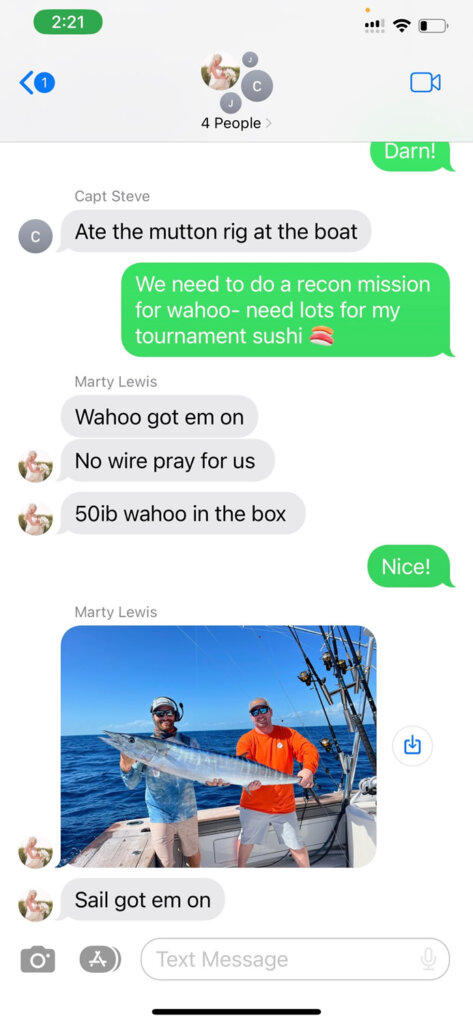
Marty Updating Katie and the team over group text about a Wahoo he hooked on fishing line.
Wahoo isn’t the type of fish we target frequently. In the wintertime we certainly troll for them when conditions look right and within a few days of a full moon. But for the most part, Wahoo is a wonderful bonus fish for our clients. We might catch Wahoo while heading offshore to catch Mahi or Tuna or we might see one near a floater or hook one unexpectedly in the kite. This is what makes Wahoo unique; catching them is a treat.
Pro tip: If you are explicitly targetting Wahoo in Marathon, Florida, consider trolling in a zig-zag pattern from east to west and vice versa. When you hit the 120 ft depth Zig North and the 250 depth Zig South. Try darker colors like black and red or purple, especially on a cloudy day.
When asked what bait to use for Wahoo, Captain Marty said “Wahoo eat all kinds of bait. You don’t need to pull a fancy $70 lure. A Wahoo will eat a Bonita strip on a two-dollar skirt if you pull it at the right speed.”
Captain Marty was referring to a strip of skin, usually, the belly, taken from a Bonita, also known as Little Tunny or False Albacore. If you cut the skin into a long thin strip attached to a hook and skirt, you make a cheap lure. Here in the Keys, this is sometimes referred to as “a snack”.
Captain Marty continued,” When there’s a full moon in the winter, I like to Kite fish for Wahoo. I’ll live bait for them, too, if there isn’t enough wind to fly the Kite. Goggle Eyes and Herrings are great baits for that.”
Marty said when asked how he finds Wahoo, ” I look for them near sunken wrecks, rock piles, any structure that might hold prey. When I live bait for them, it’s usually in less than 300 feet of water. They bite real good when that first cold front of the year comes in.” We asked Captain Marty how else he catches Wahoo, and he replied “I troll for them fast, anywhere from 10-14 Knots. In the summer, I find them under floating logs, long ropes, pallets, and other floating debris. There are many ways to catch them.”
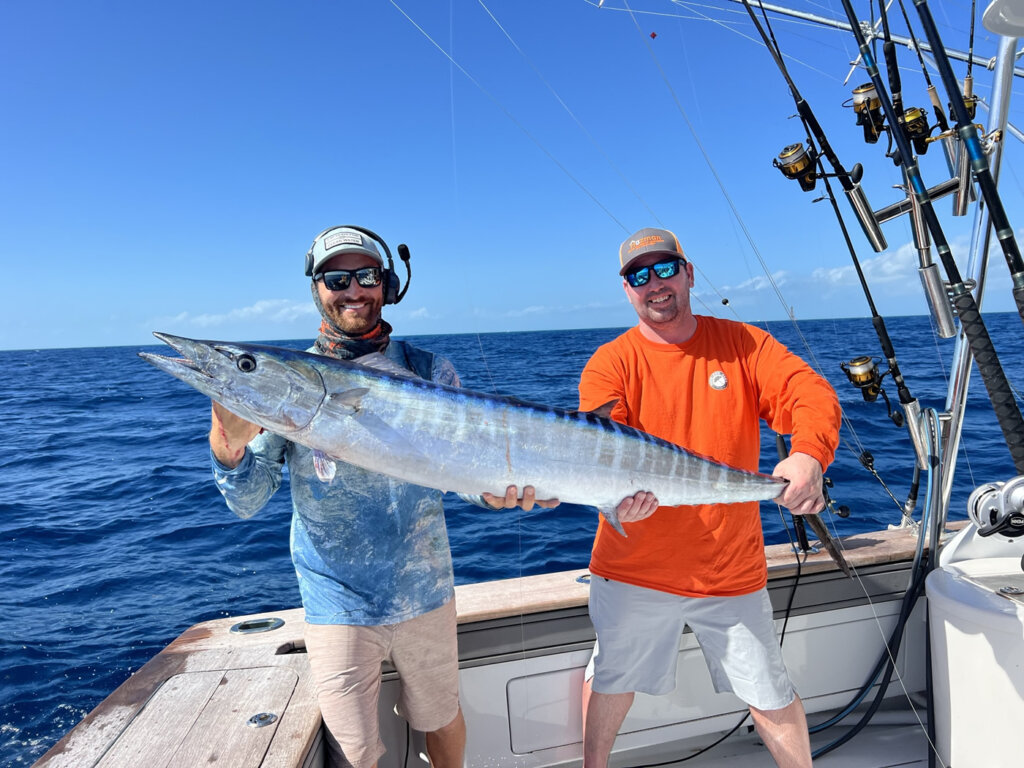
Take your Wahoo photos right after you land it, before those iconic zebra stripes are gone.
Hooked one! Now What?
When you combine the speed of the boat, and the frantic Wahoo swimming in the opposite direction, the hole made by the hook in the fish’s mouth opens up. Any slack in the line will likely allow the hook to fall out of the fish’s mouth and get away. This is why our Captains keep the boat moving after hooking up to keep the line tight.
The angler must also wind quickly to ensure the line stays tight. Captain Marty Lewis doesn’t slow down to boat the fish, either. He Keeps the Main One moving at a steady 3-6 mph while his Mate leaders and gaffs the fish behind the boat’s transom.
Once the Wahoo is successfully gaffed and in the boat, you will likely hear some sighing with relief and others cheering Wahoo! Either way, it is a beautiful moment when it happens.
How to prepare freshly caught Wahoo
So now you are lucky enough to have some fresh caught Wahoo in your possession. What do you do now? In Hawaii, they call this fish Ono which translates to delicious or good to eat. They call it that name for an excellent reason. Wahoo is a highly prized fish because of its superb eating quality.
Many fish from the mackerel family are oily and have a gamey taste, such as the Wahoo’s cousin, the King Mackerel (a.k.a. Kingfish). Wahoo is different; it tastes sweet and has a mild flavor. The firm texture and flaky white meat are highly coveted. Some say Wahoo tastes like veal!
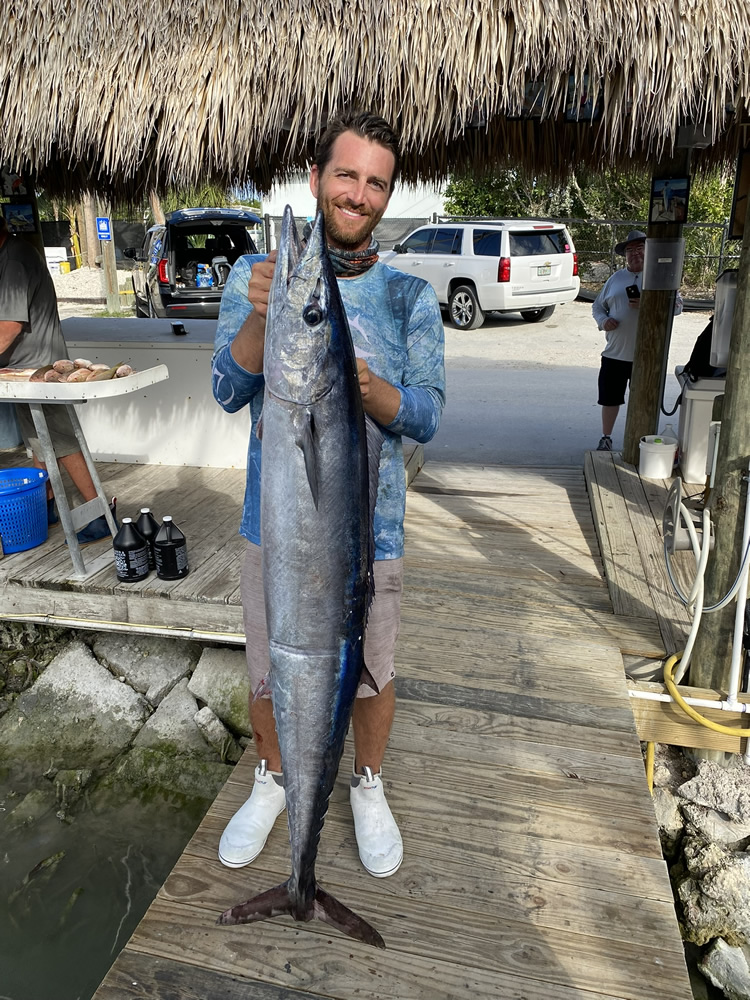
Always ice your Wahoo well, so the meat is in perfect condition when you return to the dock.
Wahoo is delicious raw and considered an excellent fish for sashimi and sushi. You want to eat it freshly caught for the best taste. Wahoo is a great starter fish for Sushi beginners because it is mild and doesn’t have a “fishy” flavor.
If you plan to cook Wahoo, consider using the grill or the oven. Just be gentle with the cook; since the meat is lean, it is easy to overcook. If you plan to grill your Wahoo, consider cutting it into steaks instead of the traditional filet. You only need a touch of salt and perhaps some olive oil and maybe a squirt of lemon; the fish is so tasty it doesn’t need much.
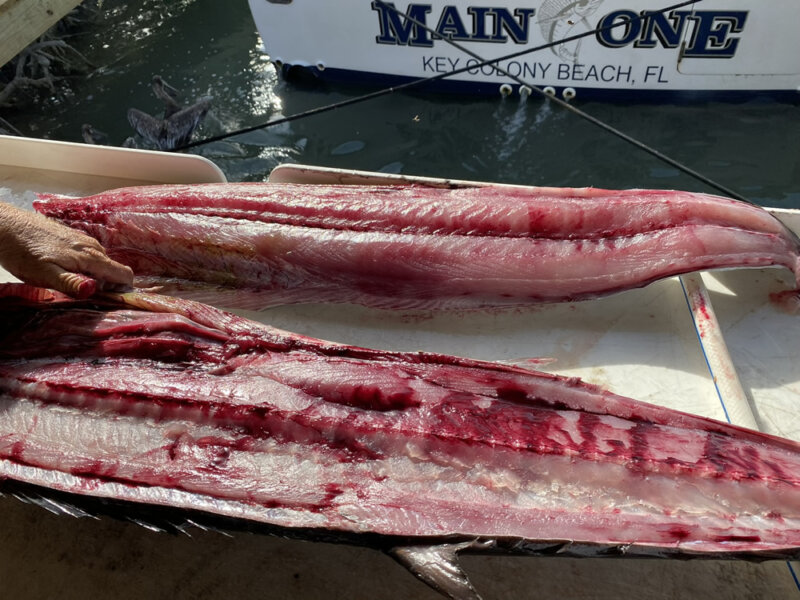
Captain Marty has filleted many Wahoo in his life time; the result speaks for itself!
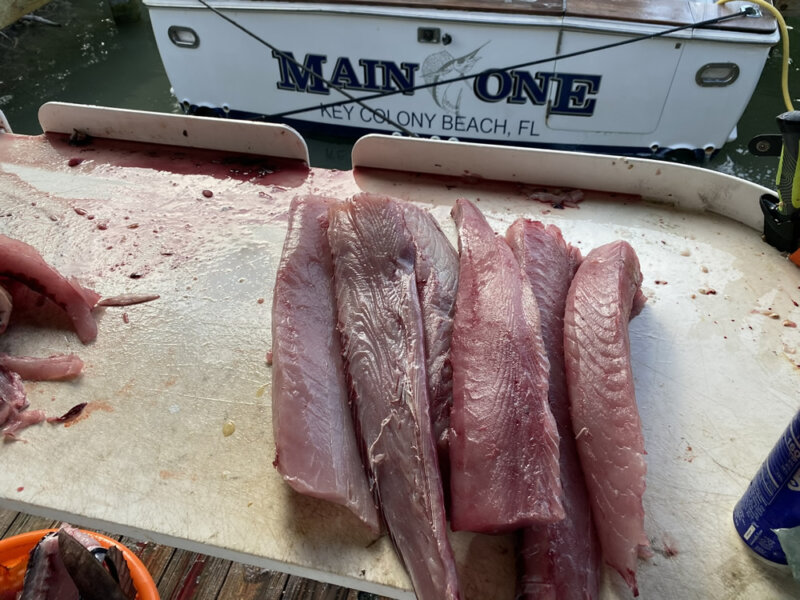
Wahoo fillets are prized in the Florida Keys, and many other parts of the world.
Population and Conservation
Because Wahoo travel great distances, often alone or in small groups, it is challenging to know how many are out there. Except in Hawaii, Wahoos are often only caught as bycatch on commercial fishing long lines. Recreational anglers love catching Wahoo, but can’t catch them in high numbers, which also protects the fishery.
It has long been thought that the Wahoos population is stable and plentiful due to their ability to reach sexual maturity quickly and proliferate. Local regulators have been using data from anglers to track how many Wahoos are being caught to determine the strength of their population.
To ensure Wahoo populations remain healthy, the South Atlantic Fishery Management council has commercial and recreational limits on both Wahoo in federal waters along the entire Atlantic coast of the USA. If your vessel is federally permitted, you must abide by these regulations even when fishing in state waters! If you are fishing recreationally in Florida state waters on a not federally licensed vessel, you can follow the FWC regulations on Wahoo instead.
In May of last year (2022), the council reduced Dolphinfish bag limits in federal waters and planned to do the same for Wahoo. They also scheduled to lower the daily Wahoo bag limit from two fish to one but received considerable pushback on this change. Local fishing advocates pointed out that cutting the limit in half would only reduce landings by 2.9% because most recreational boats in Florida do not catch more than one Wahoo in a day. The council agreed, and even today, the limit remains at two fish per day (at the time of writing this article).
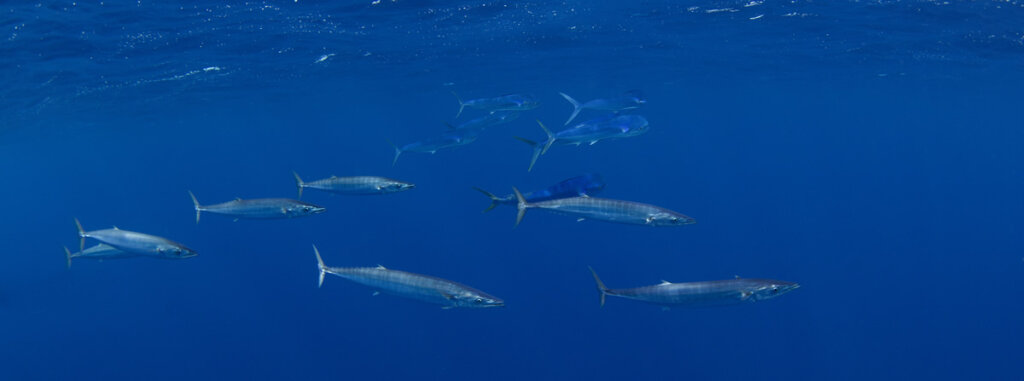
A group of Wahoos, presumably looking for food, with a school of Dolphinfish in the background.
Conclusion
So there it is; the Wahoo is a pretty interesting fish. It is not something we catch daily in the Keys, making it special. It is also one of the most prized to consume, making it even more desirable. So the next time you are fishing, toss out a high-speed lure and pull it every time you travel on the water; who knows, you might get lucky!
If you would like to catch a Wahoo this winter season, consider booking Captain Marty Lewis a few days before or after the full moon, and if conditions are right, he will try and get you one! Call us at 305-289-0071 or visit our contact page for more information.




